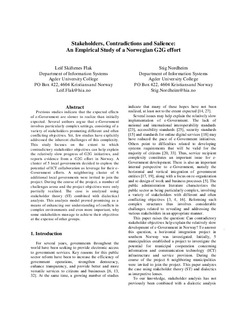Stakeholders, Contradictions and Salience : An Empirical Study of a Norwegian G2G Effort
Journal article, Peer reviewed
Permanent lenke
http://hdl.handle.net/11250/136293Utgivelsesdato
2006Metadata
Vis full innførselSamlinger
Originalversjon
Flak, L. S. & Nordheim, S. (2006). Stakeholders, Contradictions and Salience : An Empirical Study of a Norwegian G2G Effort. In Proceedings of the Annual Hawaii International Conference on System Sciences (pp. 1-10). IEEE. http://dx.doi.org/10.1109/HICSS.2006.436Sammendrag
Previous studies indicate that the expected effects of e-Government are slower to realize than initially expected. Several authors argue that e-Government involves particularly complex settings, consisting of a variety of stakeholders promoting different and often conflicting objectives. Yet, few studies have explicitly addressed the inherent challenges of this complexity. This study focuses on the extent to which contradictory stakeholder objectives can help explain the relatively slow progress of G2G initiatives, and reports evidence from a G2G effort in Norway. A cluster of 5 local governments decided to explore the potential of ICT collaboration as leverage for their e-Government efforts. A neighboring cluster of 6 additional local governments were invited to join the project. During the course of the project, a number of challenges arose and the project objectives were only partially realized. The case is analyzed using stakeholder theory (ST) combined with dialectical analysis. This analysis model proved promising as a means of enhancing our understanding of conflicts in complex environments and even more important, why some stakeholders manage to achieve their objectives at the expense of other groups.
Utgiver
IEEESerie
Hawaii International Conference on Systems Sciences; no. 39Tidsskrift
Proceedings of the Annual Hawaii International Conference on System SciencesOpphavsrett
© 2006 IEEEPersonal use of this material is permitted. Permission from IEEE must be obtained for all other uses, in any current or future media, including reprinting/republishing this material for advertising or promotional purposes, creating new collective works, for resale or redistribution to servers or lists, or reuse of any copyrighted component of this work in other works.
